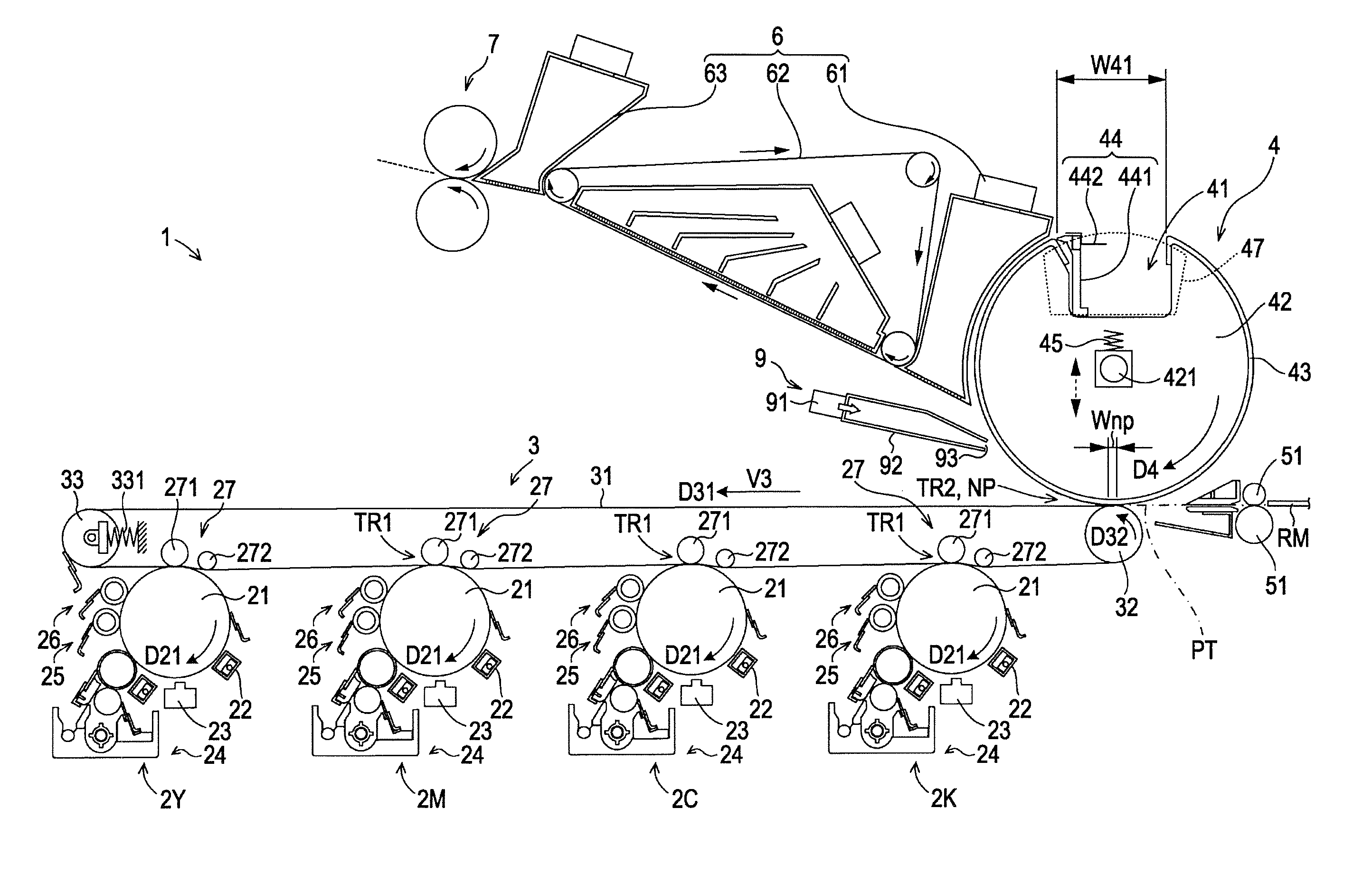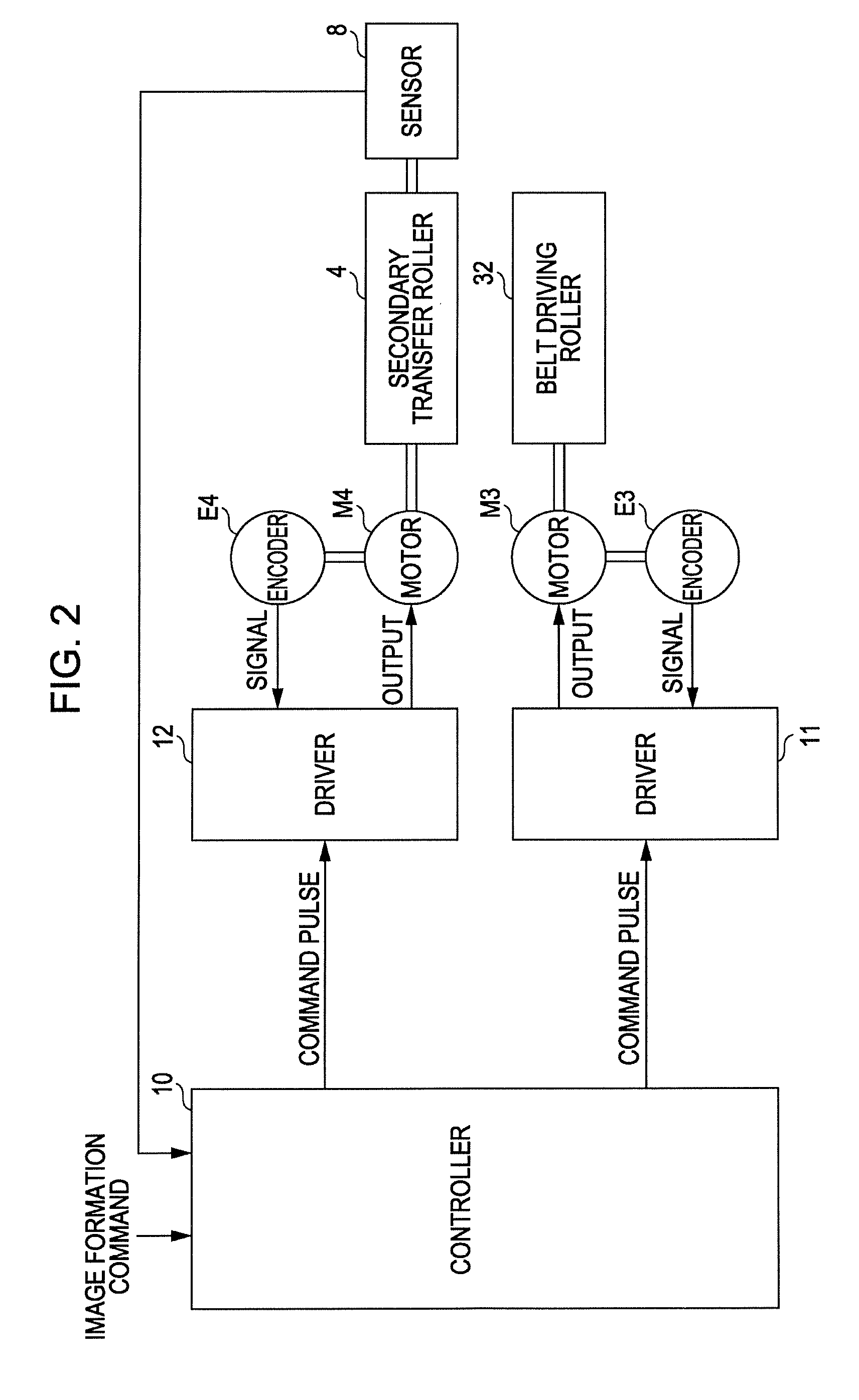[0006]An
advantage of some aspects of the invention is to provide, in an image forming apparatus provided with an image bearing member that bears an image and a transfer roller that makes contact with the image bearing member and that has a concave portion in its circumferential surface, and in a method for forming an image using such an image forming apparatus, a technique for suppressing fluctuations in the speed of the image bearing member and preventing disturbances in images caused by such fluctuations.
[0010]In the case where the circumferential surface of the transfer roller that faces the image bearing member is not a uniform cylindrical surface and instead has a concave portion in one part thereof, the torque required to rotate the transfer roller increases suddenly particularly when the surface of the transfer roller that faces the image bearing member changes from the concave portion to the circumferential surface aside from the concave portion, the transfer roller and the image bearing member make contact with each other, and the transfer nip is formed. Such a fluctuation in the torque leads to fluctuations in the speed of the image bearing member, which in turn causes disturbances in the formation of the image on the image bearing member. In response to this, with the aspect of the invention configured as described above, when the transfer roller makes contact with the image bearing member, the transfer roller makes contact with the image bearing member while moving away from the image bearing member. Accordingly, a sudden torque increase occurring when the transfer roller and the image bearing member make contact with each other is softened, and fluctuations in the speed of the image bearing member caused by torque fluctuations are suppressed. It is thus possible to reduce disturbances in the image caused by fluctuations in the speed of the image bearing member.
[0011]In the stated image forming apparatus, an adjustment unit that, for example, moves the
rotational axis of the transfer roller closer to or away from the image bearing member may be further provided. Doing so makes it possible to maintain an appropriate interval between the rotational axis of the transfer roller and the image bearing member and impart an appropriate
contact pressure between the two when the transfer nip is formed, and also makes it possible to soften an increase in the torque when the two come into contact with each other.
[0012]More specifically, the adjustment unit may include, for example, a biasing member that biases the transfer roller toward the image bearing member and a holding member that holds the distance between the rotational axis and the image bearing member against the bias exerted by the biasing member. By biasing the transfer roller toward the image bearing member and controlling the interval between the rotational axis thereof and the image bearing member, it is possible both to control the
contact pressure at the transfer nip and soften an increase in the torque at the time of contact. Note that the holding member may be a member that functions only when the concave portion of the transfer roller is facing the image bearing member.
[0014]In this case, the distance between the rotational axis and the image bearing member when the circumferential surface of the transfer roller aside from the concave portion makes contact with the image bearing member due to the rotation of the transfer roller may be made less than the distance between the rotational axis and the image bearing member when the circumferential surface of the transfer roller aside from the concave portion has made contact with the image bearing member and rotated for a predetermined amount of time. Alternatively, the distance between the rotational axis and the image bearing member may become maximum after the transfer roller and the image bearing member have made contact with each other, and the distance between the rotational axis and the image bearing member may then decrease with the rotation of the transfer roller after the distance between the rotational axis and the image bearing member has become maximum. According to either of these methods, the rotational axis of the transfer roller and the image bearing member move relative to each other so as to move away from each other when the circumferential surface of the transfer roller makes contact with the image bearing member, which makes it possible to soften sudden fluctuations in the torque at the time of the contact.
[0016]In addition, for example, a gripping portion that grips the recording material onto which the image is transferred may be provided in the concave portion. Providing such a gripping portion makes it possible to prevent, with certainty, the recording material from sticking to the image bearing member at the transfer nip. In this aspect of the invention, because providing the concave portion in the transfer roller prevents fluctuations in the speeds of the transfer roller, the image bearing member, and so on from affecting the
image formation, providing the concave portion in the transfer roller and the gripping portion in the concave portion makes it possible to prevent, with certainty, the recording material from sticking to the image bearing member, without affecting the
image formation.
 Login to View More
Login to View More  Login to View More
Login to View More 


